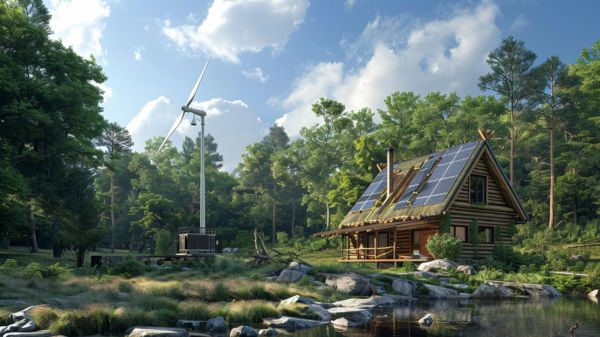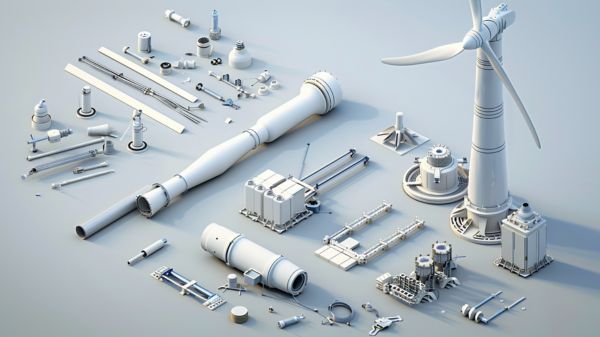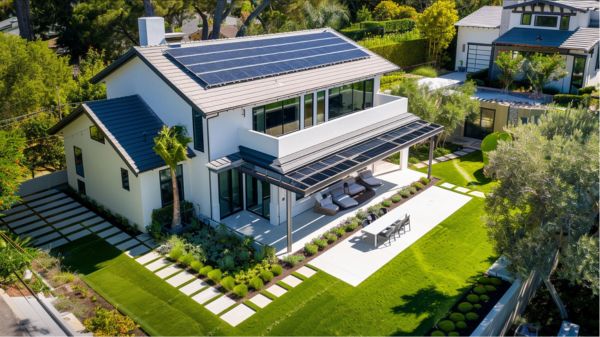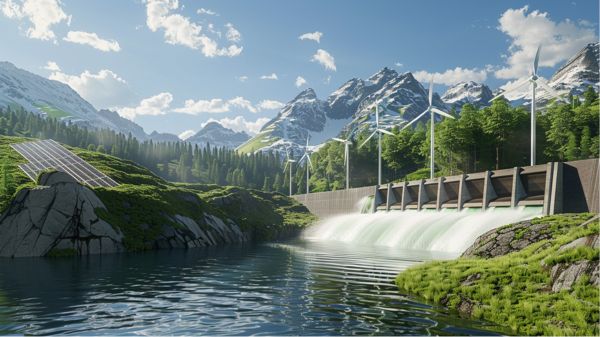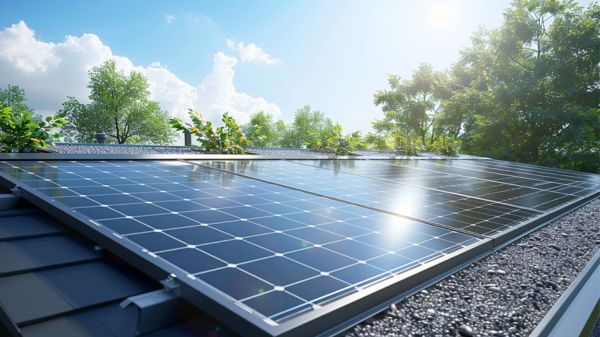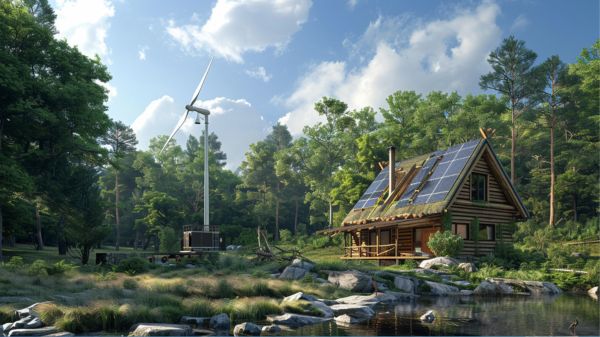7 Essential DIY Off-Grid Power Solutions for Self-Sustainability
In the pursuit of self-sustainability, mastering DIY off-grid power solutions is essential. Essential methodologies include harnessing solar energy systems that convert sunlight into electricity with an average efficiency of 22% and wind energy systems that require regular maintenance for peak performance.
Micro hydropower solutions, ranging from 5 to 100 kilowatts, harness the power of flowing water efficiently. Wood gasification systems and crank energy generators offer cost-effective and reliable off-grid power options.
Energy storage solutions, utilizing battery banks and charge controllers, guarantee power availability. Hybrid off-grid power systems combine multiple renewable sources for maximum efficiency. Each method provides unique benefits for self-sustainability.
Key Takeaways
- Solar energy systems: Harness sunlight efficiently with solar panels, batteries, and controllers for sustainable off-grid power.
- Wind energy systems: Maintain turbines for cost-effective electricity generation, optimizing wind speed and location.
- Micro hydropower solutions: Utilize water turbines for versatile energy production based on flow rate and head.
- Wood gasification systems: Convert wood into energy-rich gas for heating and power needs, a sustainable off-grid solution.
- Crank energy generators: Hand or foot-powered devices for up to 50 watts of electricity, ideal for emergencies and self-sustainability.
Solar Energy Systems
Solar energy systems harness the power of sunlight through photovoltaic cells in solar panels to generate electricity for off-grid self-sustainability. These systems consist of solar panels, inverters, battery packs, and charge controllers.
Solar panels convert sunlight into electricity through photovoltaic cells, with an average efficiency of around 22%, producing 37.5 kilowatt-hours per month. A single 250-watt solar panel can generate 1,250 watt-hours daily, while an array of 24 solar panels can yield 900 kilowatt-hours monthly.
To guarantee energy efficiency, components like batteries and charge controllers are essential in off-grid systems. By storing excess energy in batteries, these systems can provide power even when sunlight is unavailable. Charge controllers regulate the power flow from the solar panels to the batteries, preventing overcharging or deep discharge.
Solar energy systems play a significant role in utilizing renewable sources for sustainable off-grid power solutions.
Wind Energy Systems
Wind energy systems are recognized for their efficiency and reliability in generating power off-grid. To guarantee peak performance, regular maintenance is essential, including inspecting and lubricating moving parts.
Implementing maintenance tips such as checking for wear and tear, and addressing any issues promptly, can greatly extend the lifespan of wind turbines.
Wind Energy Efficiency
With the increasing global wind capacity reaching 744 gigawatts in 2020, the efficiency of wind energy systems has significantly improved, showcasing their potential for sustainable power solutions.
Renewable and off-grid, wind turbines offer a cost-effective means of generating electricity. Costs typically range between $3000 to $5000 per kilowatt, influenced by factors like size and efficiency.
The generation of energy from wind turbines heavily relies on wind speed and turbine size, determining their overall effectiveness. Additionally, height, location, and adherence to zoning laws are critical in ensuring the success of wind energy generation.
By optimizing these factors, wind energy systems can provide reliable and efficient off-grid power solutions for extended periods, contributing to self-sustainability.
Maintenance Tips
In maintaining wind energy systems for off-grid power solutions, ensuring regular inspections and timely repairs is essential to prolong the lifespan and optimize efficiency. Wind turbines typically last up to 20 years for off-grid electricity generation.
The cost of wind turbines can vary between $3000 to $5000 per kilowatt, dependent on size and type. Factors such as wind speed, turbine size, location, and zoning laws have a notable impact on energy production and efficiency. For effective maintenance, consider Solar Direct AIR 40 turbine as a reliable option.
Below is a table outlining key maintenance tips:
| Maintenance Tips | Description | Importance |
|---|---|---|
| Regular Inspections | Check for wear and tear | High |
| Lubrication | Ensure smooth operation | Medium |
| Blade Cleaning | Remove debris | Low |
Micro Hydropower Solutions
Micro hydropower systems are known for their capacity ranging from 5 to 100 kilowatts, providing a continuous and reliable energy source.
Countries like Norway demonstrate the effectiveness of hydropower, generating 98% of their energy from this sustainable solution.
Factors such as head and flow play an essential role in maximizing the power output of micro hydropower systems, emphasizing the importance of evaluating these variables when considering installation.
Efficient Water Turbines
Utilizing water turbines for micro hydropower solutions presents a practical and sustainable approach to off-grid energy generation. Micro hydropower systems, ranging from 5 to 100 kilowatts, offer versatile energy production for off-grid applications.
Efficiency optimization requires considering factors like head, flow, local regulations, and water rights before installation. These systems can produce up to 10 kWh of energy, with output influenced by variables such as head and flow rate.
The WaterLily Turbine exemplifies a portable hydropower solution that harnesses electricity from flowing water, serving as a convenient off-grid energy source.
Norway’s reliance on hydropower, generating 98% of its energy, highlights the reliability and sustainability of micro hydropower systems for achieving self-sustainability.
Stream Power Potential
With a focus on harnessing the power of flowing streams, micro hydropower systems demonstrate significant potential for off-grid energy generation. Ranging from 5 to 100 kilowatts, these systems offer continuous energy production, making them a reliable choice for sustainable power generation. Norway sets a prime example by generating 98% of its energy from hydropower, highlighting the reliability and sustainability of such solutions.
Factors such as head, flow rates, and water rights play vital roles in determining the power generation capacity of micro hydropower systems. The WaterLily Turbine, a portable hydropower option, efficiently generates electricity from moving water, catering to off-grid applications. With the capability to reach 10 kWh of energy production, micro hydropower systems present a viable path towards achieving self-sustainability.
Wood Gasification Systems
Essentially, wood gasification systems efficiently convert organic material into energy-rich gas to provide sustainable off-grid solutions for heating, cooking, and power generation. By utilizing wood as a renewable resource, these systems offer a reliable energy source with minimal environmental impact. With decades of proven use in remote locations, wood gasification technology can generate electricity and heat tailored to varying off-grid energy needs.
The versatility of wood gasification systems makes them an attractive option for those seeking self-sustainability. These systems can be adjusted to meet specific energy requirements, making them adaptable to different situations. Essentially, wood gasification systems represent a cost-effective and eco-friendly way to harness energy from natural resources, allowing individuals to reduce their dependence on traditional power sources.
Whether used for residential heating or small-scale electricity generation, wood gasification systems provide a sustainable and efficient off-grid energy solution.
Crank Energy Generators
In the field of off-grid power solutions, crank energy generators stand out as efficient hand or foot-powered devices capable of producing up to 50 watts of electricity.
These portable hand crank generators are a sustainable way to generate electricity, converting human mechanical energy into usable electrical power. They serve as reliable backup power sources for emergencies or off-grid situations, where conventional power sources may be unavailable.
Electric Pedals offers powerful hand crank generators that are useful for charging small electronic devices or providing light power needs. These generators do not rely on fuel or sunlight, making them a practical option for self-sustainability.
Below is a comparison table highlighting some key features of crank energy generators:
| Feature | Description |
|---|---|
| Power Output | 5-50 watts |
| Portability | Easily portable |
| Application | Backup power for emergencies or off-grid scenarios |
Energy Storage Solutions
An integral component of off-grid power systems, energy storage solutions play a significant role in ensuring consistent power availability during periods of low energy generation. When it comes to energy storage in off-grid setups, several options are available to explore:
- Battery banks: Essential for storing excess energy generated by off-grid systems.
- Lead-acid batteries: Cost-efficient and commonly used for energy storage in off-grid applications.
- Lithium-ion batteries: Offer higher energy density and longer lifespan, making them ideal for off-grid systems.
- Charge controllers: Efficiently regulate the flow of energy to and from battery banks, ensuring effective performance and longevity in off-grid setups.
The energy storage capacity provided by these solutions directly impacts power availability during times when energy generation is limited. Choosing the right combination of storage solutions based on factors like energy density, cost-efficiency, and lifespan is important for achieving self-sustainability in off-grid power systems.
Hybrid Off-Grid Power Systems
Energy storage solutions are fundamental in off-grid power systems, and when it comes to enhancing efficiency and reliability, hybrid off-grid power systems emerge as a strategic approach by combining multiple renewable energy sources.
These systems integrate backup power options such as generators or battery storage to guarantee continuous energy availability for off-grid living. By leveraging different energy sources like solar, wind, and hydro, hybrid systems offer a reliable solution to meet varying energy needs and ensure a continuous supply of power.
The combination of these renewable energy sources in a hybrid system not only maximizes energy production but also minimizes the reliance on a single source, increasing overall system resilience. Additionally, the scalability of hybrid off-grid power systems allows for customization based on specific energy requirements and site characteristics, providing a versatile solution for individuals seeking self-sustainability through diverse energy options.
Related Post: 5 Cost-Effective Energy Storage Solutions for Off-Grid Living.
Frequently Asked Questions
How Do You Sustain Yourself Off-The-Grid?
To sustain oneself off-the-grid involves a holistic approach encompassing water collection, solar panels, wind turbines, food preservation, composting toilets, rainwater harvesting, wood stoves, energy storage, emergency preparedness, and sustainable farming. This integrated system guarantees self-sufficiency and resilience.
What Is the Best Power Source for Off-Grid Living?
The best power source for off-grid living depends on location, resources, and energy needs. Solar panels are versatile and widely used. Wind turbines offer consistent power in windy areas. Hydro power is reliable near water sources. Geothermal energy harnesses heat underground. Biomass fuel, propane generators, fuel cells, and micro hydro systems provide alternative options.
What Is the Most Sustainable Way to Generate Electricity?
The most sustainable ways to generate electricity include solar panels harnessing sunlight, wind turbines utilizing wind power, and hydropower from water sources. Biomass energy, geothermal power, microgrids, battery storage, and energy efficiency also contribute to renewable resources and green technology.
What Is Off-Grid Sustainability?
Off-grid sustainability centers on utilizing renewable resources to achieve self-reliance and energy independence. It fosters sustainable living by minimizing environmental impact through alternative energy sources. Embracing off-grid benefits requires sustainable practices to overcome challenges and attain self-sufficiency.
Conclusion
Incorporating various off-grid power solutions such as solar energy systems, wind energy systems, micro hydropower solutions, wood gasification systems, crank energy generators, energy storage solutions, and hybrid off-grid power systems can greatly enhance self-sustainability.
These systems offer a diverse range of options for generating and storing power, ensuring a reliable and efficient source of energy even in remote or off-grid locations.
By utilizing these technologies, individuals can reduce their dependence on traditional power sources and achieve greater self-sufficiency.
